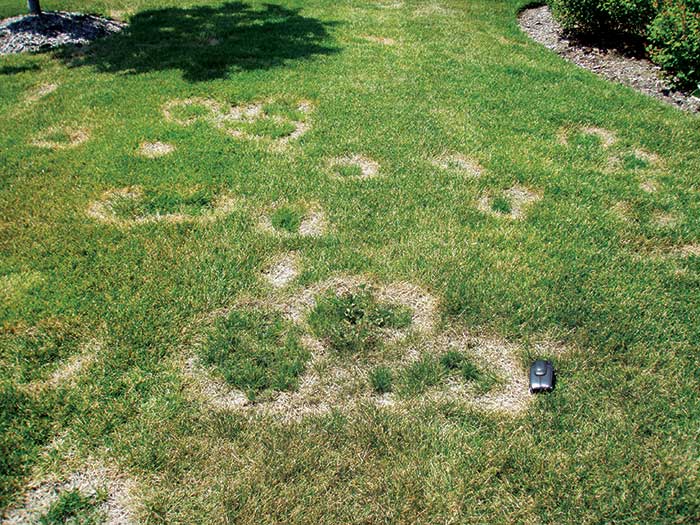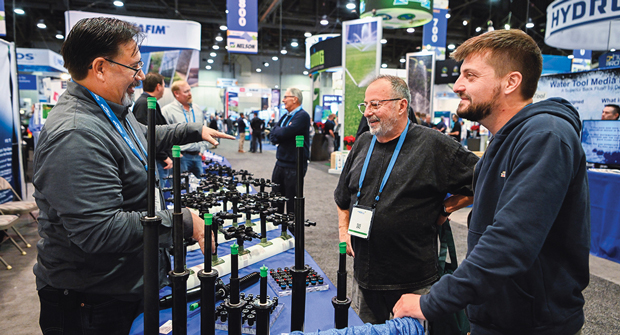Know the signs of necrotic ring spot in turf

Necrotic ring spot often appears in Kentucky bluegrass where the organic layer under the soil has built up. (Photo: Paul Koch, Ph. D.)
The frog-eye appearance observed in Kentucky bluegrass is a trademark of necrotic ring spot. While this pathogen is different than summer patch, Jim Kerns, Ph.D., associate professor in the Department of Entomology and Plant Pathology at North Carolina State University, says that since the organisms of the two diseases are similar, they are often lumped in together.
When Kerns was studying at the University of Wisconsin, he says necrotic ring spot and summer patch were almost indistinguishable. Necrotic ring spot, though, tends to only plagues Kentucky bluegrass. However, he did notice some differences in the development of the pathogens as spring turned to summer.
“With the necrotic ring spot, it starts to develop when soil temperatures get around 60 to 65 degrees, and it doesn’t continually develop all summer long like summer patch would,” he says. “It will stop when it gets really hot.”
Necrotic ring spot often shows up on bluegrass where the organic layer beneath the soil has built up due to a reduction in aerification.
“That may be especially true for areas of the country that reduced maintenance because of the pandemic,” he says. “Not aerifying fairways and cutting back fertility on fairways and roughs could cause necrotic ring spot or summer patch to creep back in if it wasn’t a problem in the past.”
Kerns says the same fungicides that tackle summer patch will also control necrotic ring spot, but management strategies should also include proper fertility and aerification to reduce the symptoms of necrotic ring spot.
“It’s making sure they’re following fertility recommendations for Kentucky bluegrass in their region,” Kerns says. “If you overfertilize and produce more of (an organic) layer, that will make necrotic ring spot more severe.”
Greene County Fertilizer Co.

Josh Weaver (Headshot: Green County Fertilizer Co.)
Josh Weaver, Ph.D.
Director of research and horticulture
The necrotic ring spot pathogen is a soil-borne fungus, Ophiosphaerella korrae. Root infections are favored by unseasonably cool, wet weather in late April and May. The disease is often more severe in areas where the soil dries out more quickly, such as on knolls or slopes. One factor favoring disease development is heavy nitrogen application during spring or summer. Spring and summer fertilizer applications, especially fast-release formulations such as urea, stimulate rapid turfgrass growth and favor necrotic ring spot. Consider the use of low input, slow- or controlled-release nitrogen for spring applications to maintain turfgrass color. Cool-season grasses should receive heavier applications of slow-release forms of nitrogen fertilizer in the fall. This best management practice has been shown to reduce disease severity in sites with serious necrotic ring spot problems during autumn and early winter.
LebanonTurf
Christopher Gray
Golf market manager
Since NRS is a disease caused by soil-borne fungi, the pathogens stay in the soil for long periods, making this common disease a constant threat to the turf. Effective cultural practices are the most effective long-term solution to managing it. Start by improving the health of your soil, which is most easily achieved with multiple applications of humates (granular humic acid). In terms of fertilizer, it’s imperative to maintain adequate levels of potassium and phosphorus, as well as optimal nitrogen levels. However, avoid applying excessive amounts of nitrogen, especially during the spring and summer; applications of more than 1 pound will enhance NRS severity. Slow-release (methylene urea) and organic forms of nitrogen are recommended.
Foley Co.

Greg Turner (Headshot: Foley Co.)
Greg Turner
Global sales director
Necrotic ring spot (NRS) is a difficult disease to manage because of its perennial nature. At the time of the year (July to September) when NRS is thriving, most aeration practices cannot be used. Yet, compaction and lack of porosity increase as does NRS. Air2G2 uses 12-inch probes to penetrate the turf’s surface. The first injection of air occurs between 5 to 7 inches and the second between 10 to 12 inches. Used frequently, Air2G2 will decrease compaction and increase porosity, air supply to the roots, fertilization and fungicide effectiveness and gas exchange at the most critical times when NRS is thriving. Remember, NRS is a fungus, and its spores can be transferred via foot traffic and machinery that comes in contact with NRS. To help prevent the spread, clean equipment with a combination of rubbing alcohol and water to sterilize before next use.
Mountain View Seeds

Gregg Munshaw (Headshot: Gregg Munshaw)
Gregg Munshaw, Ph.D.
Director of agronomy
The fungus that causes necrotic ring spot (Ophiosphaerella korrae) is active in the soil and infects roots, rhizomes and crowns. While there are several chemical control options, management practices that can promote healthy roots may help with controlling this disease. Practices such as a higher height of cut, watering deeply and infrequently, maintaining balanced fertility and using slow-release sources, aerifying to reduce compaction and managing thatch can all help to reduce the severity of this disease. One of the easiest (and cheapest) things we can do to combat diseases, however, is to plant improved varieties. Even if you can’t completely renovate your turf, interseeding in new genetics can help reduce disease pressure. Cultivars such as Hampton and Blue Note have shown high degrees of necrotic ring spot resistance in NTEP testing.













